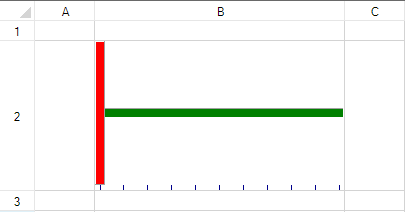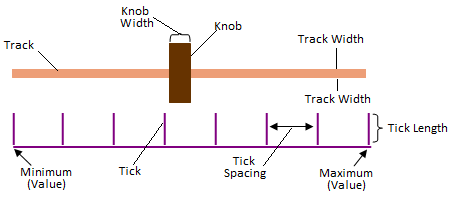-
Spread Windows Forms 18 Product Documentation
- Getting Started
-
Developer's Guide
- Understanding the Product
- Working with the Component
- Spreadsheet Objects
- Ribbon Control
- Sheets
- Rows and Columns
- Headers
- Cells
-
Cell Types
- Understanding Cell Type Basics
- Understanding How Cell Types Work
- Understanding How Cell Types Display and Format Data
- Understanding How Cell Type Affects Model Data
- Working with Editable Cell Types
-
Working with Graphical Cell Types
- Setting a Barcode Cell
- Setting a Button Cell
- Setting a Check Box Cell
- Setting a Color Picker Cell
- Setting a Combo Box Cell
- Setting a Hyperlink Cell
- Setting an Image Cell
- Setting a List Box Cell
- Setting a Multiple-Column Combo Box Cell
- Setting a Multiple Option Cell
- Setting a Progress Indicator Cell
- Setting a Slider Cell
- Understanding Additional Features of Cell Types
- Data Binding
- Customizing the Sheet Appearance
- Customizing Interaction in Cells
- Tables
- Understanding the Underlying Models
- Customizing Row or Column Interaction
- Formulas in Cells
- Sparklines
- Keyboard Interaction
- Events from User Actions
- File Operations
- Storing Excel Summary and View
- Printing
- Chart Control
- Customizing Drawing
- Touch Support with the Component
- Spread Designer Guide
- Assembly Reference
- Import and Export Reference
- Version Comparison Reference
Setting a Slider Cell
A slider cell displays a slider control in the cell.

To create a cell that acts like a slider, use the SliderCellType class and follow the procedure described in this topic.
Customizing the Slider
The parts of the slider (corresponding to their property names) are shown here. For this example, the orientation is horizontal and solid colors are used (as opposed to pictures).

You can customize the display and operation of the slider in the cell by setting the following properties.
Property | Customization |
|---|---|
Sets the background image for the cell. | |
Sets whether the slider moves with the initial click. | |
Sets the color of the slider knob. | |
Customizes the slider knob image. | |
Sets the width (in pixels) of the slider knob. | |
Sets the maximum value for user entry. | |
Sets the minimum value for user entry. | |
Sets the orientation of the slider. | |
Sets the color of the slider tick mark. | |
Sets the size of the slider tick mark. | |
Sets how frequently to space the tick marks. | |
Sets the color of the slider track. | |
Customizes the image for the slider track. | |
Sets the width (in pixels) of the slider track. |
You can programmatically change the location of the knob in the slider cell by setting the Value property to a value that is greater than or equal to the minimum or less than or equal to the maximum setting.
Note that some graphical elements in certain cell types are affected by XP themes (visual styles). Setting the VisualStyles property of the Spread component to "off" can allow visual customizations of those graphical cell types to work as expected. For more information, refer to Using XP Themes with the Component.
For more information on the properties and methods of this cell type, refer to the SliderCellType class.
Using the Properties Window
At design time, in the Properties window, select the Spread component.
Select the Sheets property.
Click the button to display the SheetView Collection Editor.
In the Members list, select the sheet in which the cells appear.
In the property list, select the Cells property and then click the button to display the Cell, Column, and Row Editor.
Select the cells for which you want to set the cell type.
In the property list, select the CellType property and choose the Slider cell type.
Expand the list of properties under the CellType property. Select and set these specific properties as needed.
Click OK to close the Cell, Column, and Row Editor.
Click OK to close the SheetView Collection Editor.
Using Code
Define the slider cell by creating an instance of the SliderCellType class.
Format and specify the appearance of the slider.
Assign the slider cell type to a cell or range of cells by setting the CellType property for a cell, column, row, or style to the SliderCellType object.
Example
This example creates a slider cell.
fpSpread1.ActiveSheet.Columns[1].Width = 250;
fpSpread1.ActiveSheet.Rows[1].Height = 150;
fpSpread1.VisualStyles = FarPoint.Win.VisualStyles.Off;
FarPoint.Win.Spread.CellType.SliderCellType slider = new FarPoint.Win.Spread.CellType.SliderCellType();
slider.BackgroundImage = new FarPoint.Win.Picture(Image.FromFile("C:\\images\\scene.jpg"));
slider.ChangeOnFocus = true;
slider.KnobColor = Color.Red;
// Or if you want to use an image instead of a solid color:
// slider.KnobPicture = new FarPoint.Win.Picture(Image.FromFile("..\\images\\brush.gif"));
slider.KnobWidth = 10;
slider.Maximum = 200;
slider.Minimum = 0;
slider.Orientation = FarPoint.Win.SliderOrientation.Horizontal;
slider.TickColor = Color.DarkBlue;
slider.TickLength = 5;
slider.TickSpacing = 20;
slider.TrackColor = Color.Green;
// Or if you want to use an image instead of a solid color:
// slider.TrackPicture = new FarPoint.Win.Picture(Image.FromFile("..\\images\\pattern.jpg"));
slider.TrackWidth = 10;
fpSpread1.ActiveSheet.Cells[1, 1].CellType = slider;fpSpread1.ActiveSheet.Columns(1).Width = 250
fpSpread1.ActiveSheet.Rows(1).Height = 150
fpSpread1.VisualStyles = FarPoint.Win.VisualStyles.Off
Dim slider As New FarPoint.Win.Spread.CellType.SliderCellType()
slider.BackgroundImage = New FarPoint.Win.Picture(Image.FromFile("C:\\images\\scene.jpg"))
slider.ChangeOnFocus = True
slider.KnobColor = Color.Red
‘ Or if you want to use an image instead of a solid color:
‘ slider.KnobPicture = New FarPoint.Win.Picture(Image.FromFile("..\\images\\brush.gif"))
slider.KnobWidth = 10
slider.Maximum = 200
slider.Minimum = 0
slider.Orientation = FarPoint.Win.SliderOrientation.Horizontal
slider.TickColor = Color.DarkBlue
slider.TickLength = 5
slider.TickSpacing = 20
slider.TrackColor = Color.Green
‘ Or if you want to use an image instead of a solid color:
‘ slider.TrackPicture = New FarPoint.Win.Picture(Image.FromFile("..\\images\\pattern.jpg"))
slider.TrackWidth = 10
fpSpread1.ActiveSheet.Cells(1, 1).CellType = sliderUsing the Spread Designer
Select the cell or cells in the work area.
In the property list, in the Misc category, select CellType. From the drop-down list, choose the Slider cell type. Now expand the CellType property and various properties are available that are specific to this cell type. Select and set those properties as needed.
Or right-click on the cell or cells and select Cell Type. From the list, select Slider. In the CellType editor, set the properties you need. Click Apply.
From the File menu choose Apply and Exit to apply your changes to the component and exit Spread Designer.
See Also
Setting a Multiple-Column Combo Box Cell


